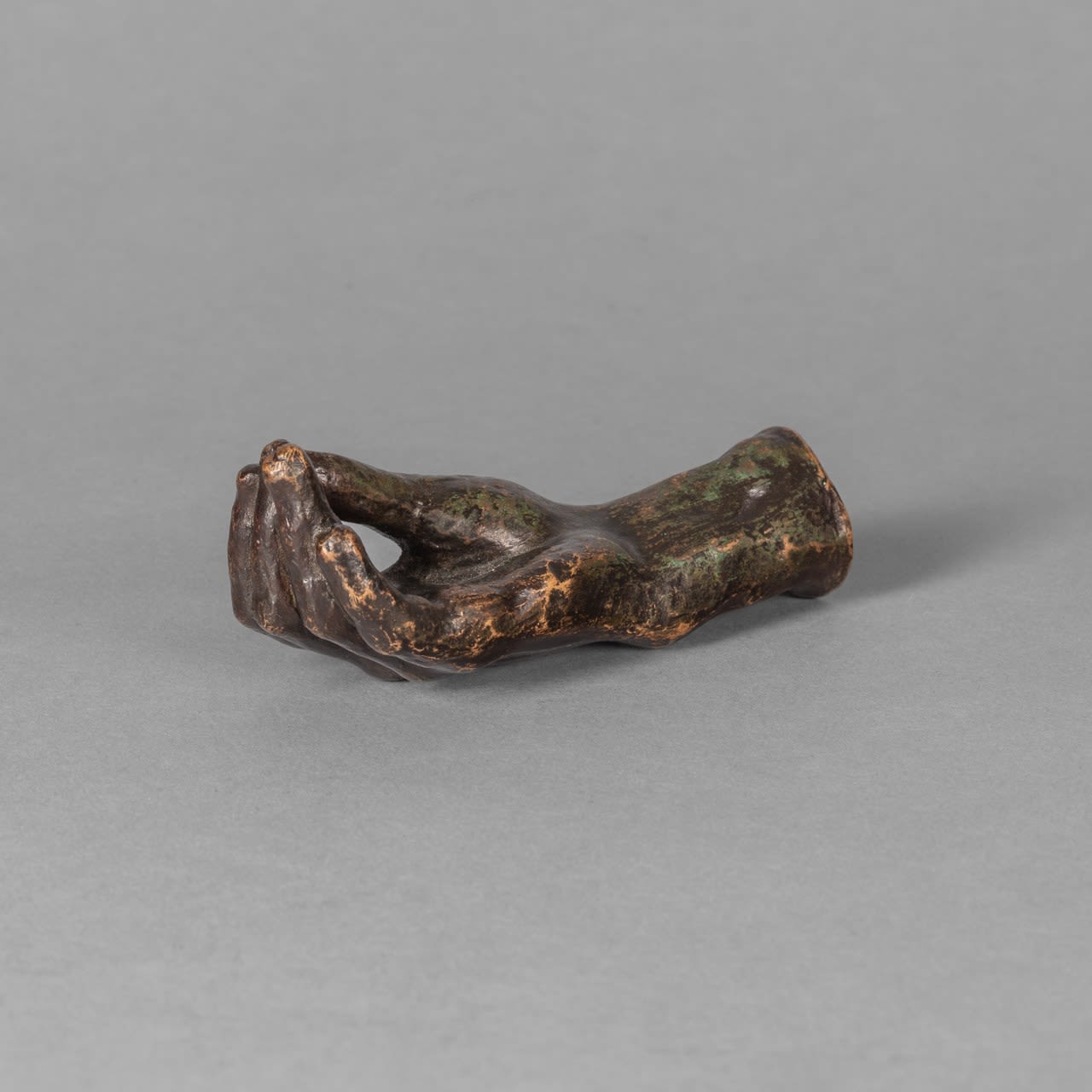Auguste Rodin 1840-1917
9.2 x 3.2 x 4 cm
Further images
Auguste Rodin (1840-1917) was a dominant figure in the world of sculpture throughout his career, although his influence reaches far beyond his years and continues today. The importance of Rodin's work cannot be overstated. Indeed, with its vitality and animation his pieces are considered to have shaped the future of sculpture and defined the modern age. Rodin's figures were inspired by classical Greek and Renaissance art, albeit he pared back narrative references to classical gods and muses by sculpting naturalistic figures whose forms reflected distinctly modern representations of love, thought and physicality. Rodin was also deeply influenced by the literary works of the Italian poet, writer, and philosopher Dante Alighieri (1265-1321), whose epic poem the Divine Comedy (c. 1320) gave rise to some of Rodin's most famous creations - The Kiss (1882); The Thinker (1904); and The Gates of Hell (c. 1880-1917).
His monumental masterpiece The Gates of Hell, for instance, comprised over two hundred and twenty five figures and groups modelled as players for this arresting construction. The Gates of Hell were initially commissioned for the new Museum of Design in Paris, but even after the plans were abandoned Rodin continued to develop figures piecemeal over a period of thirty-seven years. The artist would never see the work completed in bronze, with the process finished posthumously, but the figures Rodin formed for his gates were a vital source of inspiration for the rest of his career.
Rodin’s contemporary success did not come without controversy. One figure, in particular, scandalised the art world, with some critics suspicious of Rodin’s methods because his breakout piece was so lifelike. The Age of Bronze (1876) depicted a moment of awakening – to suffering or to joy – and was sculpted over the course of eighteen months. However, Rodin faced accusations of fraud and he was left with little choice but to vigorously deny the charges of casting from a living model, which he was only able to disprove due to the photographic records he kept from his work in the studio. Such questions of authenticity, naturally, are testament to what has been described as Rodin’s sublime talent.
Likewise, The Kiss, which was originally conceived as part of The Gates of Hell but was later completed as an independent piece, faced considerable critical censure. For conservative critics, Rodin’s entwined lovers were viewed as problematic because they were seen to depict uncontrolled carnal desire, illicit in its nature and explicit in sexual infatuation – based as it was on the characters of Paolo and Francesca from the Divine Comedy, who were punished for their transgressions and doomed to wander eternally through the corridors of Hell. The sculpture was censored on several occasions in exhibitions, which included secluding it for viewing in a separate room and, in one instance, excluding it from view altogether. In contrast to his detractors, Rodin understood The Kiss to represent the height of happiness and sensuality, and its status today as a cultural icon is such that it remains one of his most recognised and reproduced sculptures alongside The Thinker. Despite such early critical disapproval, Rodin achieved a level of fame and international popularity that was unprecedented for a sculptor.
The Musée Rodin summarised his achievements and contributions to art and sculpture when they observed that
'his genius was to express inner truths of the human psyche, and his gaze penetrated beneath the external appearance of the world. Exploring this realm beneath the surface, Rodin developed an agile technique for rendering the extreme physical states that correspond to expressions of inner turmoil or overwhelming joy. He sculpted a universe of great passion and tragedy, a world of imagination that exceeded the mundane reality of everyday existence'.
Georges Grappe, second director of the Rodin Museum, noted that this hand was the model for the smaller element in Rodin's famous assemblage The Cathedral (1906), in which two gently curved hands combine to enclose a space reminiscent of a Gothic rib vault.
Throughout his career, Rodin sculpted numerous bozzetti; small scale sculptures of hands, feet, heads and torsos, from which he would create larger assemblages. His fascination with hands in particular went beyond anatomical interest; however sculpting these models enabled him to explore proportions and form. This production was especially prevalent when Rodin was creating the monumental sculpture The Gates of Hell, which features numerous individually sculpted figures. Rodin was fascinated by hands, he created a huge array in different sizes and materials. His fascination with hands was partly due to his belief that God had given him his artistic talents therefore his hands became a symbol of his faith and his divine creativity.
Examples of Rodin's sculpture are held in collections around the world including Musée Rodin, Paris; Ny Carlsberg Glyptotek, Copenhagen; Victoria and Albert Museum, London; Metropolitan Museum of Modern Art, New York; Walker Art Gallery, Liverpool; Los Angeles County Museum of Art, Los Angeles; Getty Museum, Los Angeles.
Provenance
Rodin Museum, ParisB. Gerald Cantor, Los Angeles, by whom acquired from the previous in October 1960
Feingarten Galleries, Los Angeles
Catherine Gamble Curran, New York, acquired circa 1965
Acquired at the previous sale by the family of the owner
Exhibitions
2021: Tate, Making of Rodin (plaster version exhibited)2023: RODIN DALOU, Eros Gallery, 1-22 December
Literature
Rodin, les mains, les chirurgiens, exhib. cat., (Paris: Musée Rodin, Éditions de la Réunion des Musées Nationaux, 1983), p. 45, no. 21, and p. 105, no. 72 (plaster versions illustrated).Publications
Duck and Hamnett, RODIN DALOU exh. cat (London: Eros Gallery, 2023), 1-22 December 2023.Join our mailing list
* denotes required fields
We will process the personal data you have supplied to communicate with you in accordance with our Privacy Policy. You can unsubscribe or change your preferences at any time by clicking the link in our emails.






